When I started writing Soup Stories last year around this time and transcribing recipes thinking about others are making, I was able to find many things. Here are some tips for making delicious soups at the end of the year.
1. Fresh seasonal vegetables are what you need
For the extremely minimalist, you can make a detox soup with just a few chopped leek and a sprinkle of salt.

Soup Stories #5: Detox Leek Soup
Onions, potatoes, and carrots can be made into a gentle soup by start cooking slices of them in water, adding salt and pepper, and smoothing them out with a blender, gentle soup. Although not yet mentioned in Soup Stories, a Portuguese soup called caldo verde is a soup along these lines. I will write about it soon on Hive Blog.
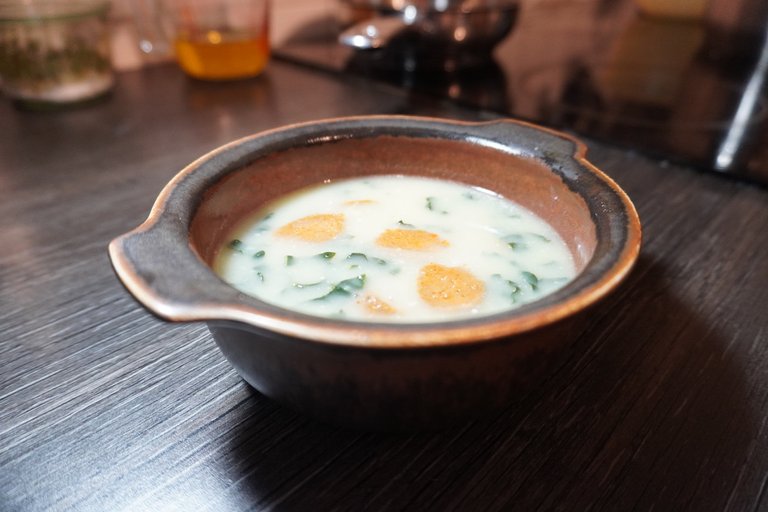
2. Basic seasonings: good salt, pepper and some more
Good salt is important. It's a bit expensive, but that's okay because you don't use tons of it. I recommend salt that is not too refined. It is delicious sprinkled on also salads and fried foods.
Pepper is essential for some soups, and it smells good when it is freshly ground, so it is a good idea to have pepper in a simple mill. I love pepper so much that I bought a large wooden mill.
In addition, miso and soy sauce are also useful. I think it is difficult to buy all kinds of herbs at once, so I recommend you to start with a simple Italian herb mix and then buy more individual ones to your liking.
3. Sautéing ingredients for richer flavor
If you sauté ingredients in butter or vegetable oil before simmering, it will give the soup a fuller, richer flavor.

4. Using umami ingredients
Umami can be produced by combining glutamic acid and inosinic acid, or glutamic acid and guanylic acid. Inosinic acid is often found in animal products, and if you want to make a plant base, the combination of glutamic acid and guanyl acid is for you. Glutamic acid is found in vegetables and guanylic acid is found in dried mushrooms. You can also add a little miso to cream soups and stews.
Dried mushrooms, dried tomatoes, and miso are umami-rich ingredients, which you must have in your kitchen as a soup fan 😁
The mushrooms on the right side of the picture below were picked and dried by a friend of mine.
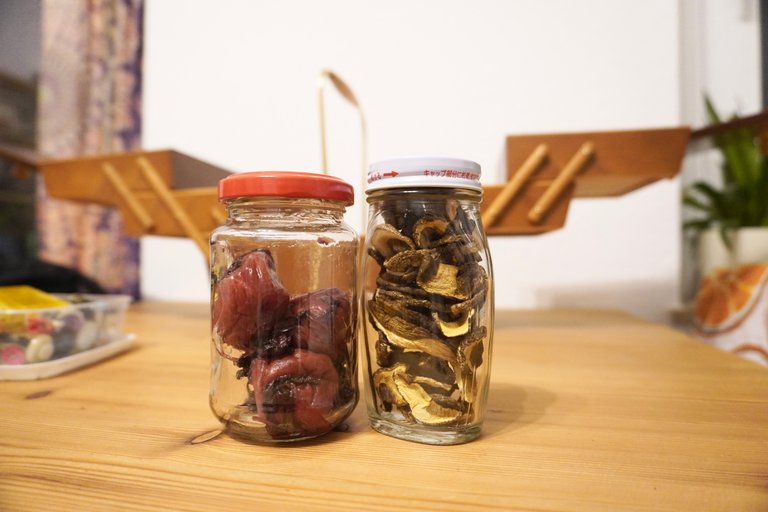
5. Adding beans, grains, or noodles to make it more satisfying
Add beans, grains, or noodles to make a satisfying dish of soup alone. Add leftover rice or beans to the soup, or simmer short pasta together when you cook or reheat soup. Soupy soup is easy to eat, even for those with a cold.
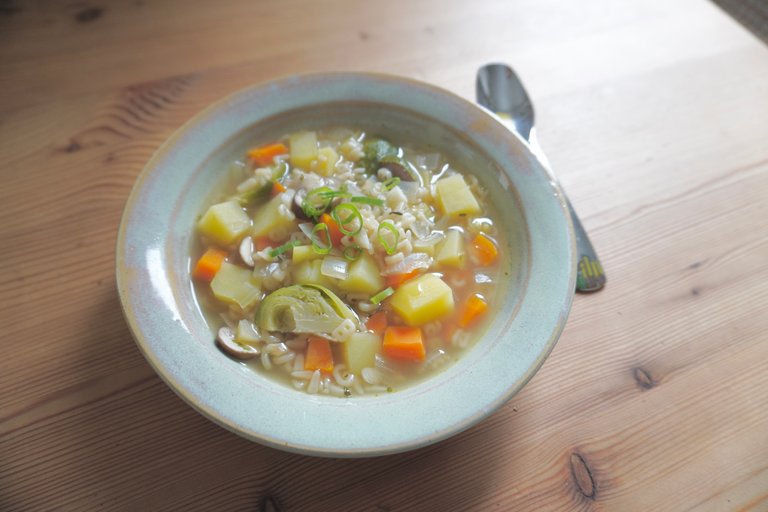
Soup Stories #19: Alphabet Pasta Soup for Colds
If you eat eggs, I recommend adding an egg. Just crack it in at the end.
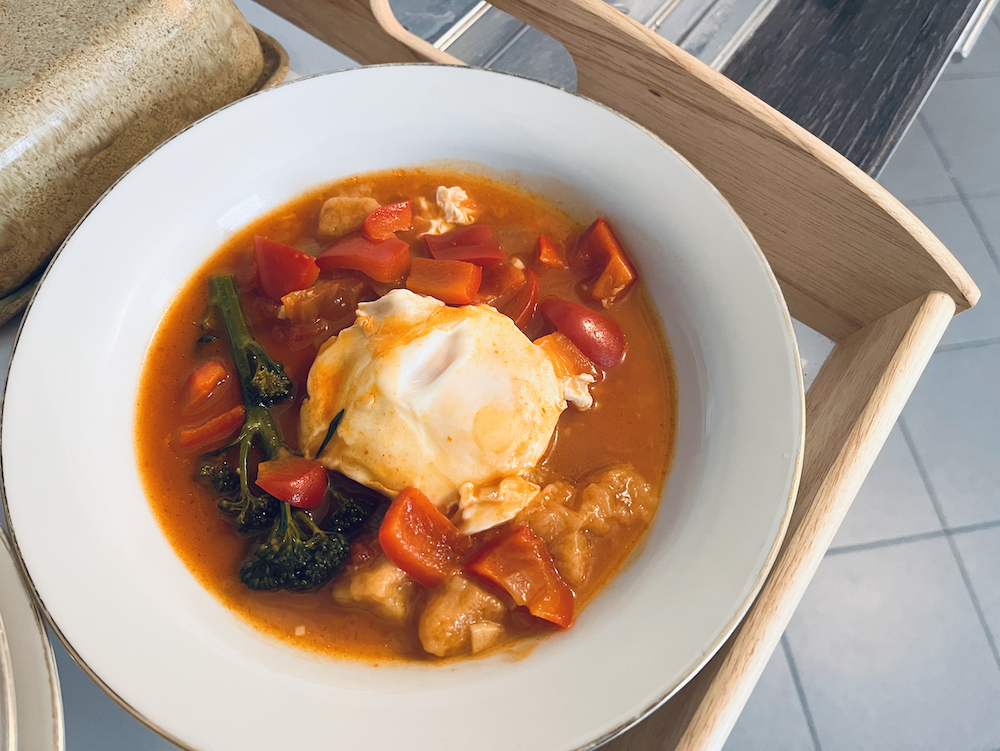
Talking about beans, keeping cooked beans in freezer is practical. I cook in a batch or buy cooked beans in a jar.
Not a must but ... using pressure cooker
I love it so much that I think about a give away in the future 😁 With a pressure cooker, slow-cooked soups such as goulash and pot-au-feu are ready in 30 minutes. It is also useful for cooking beans.
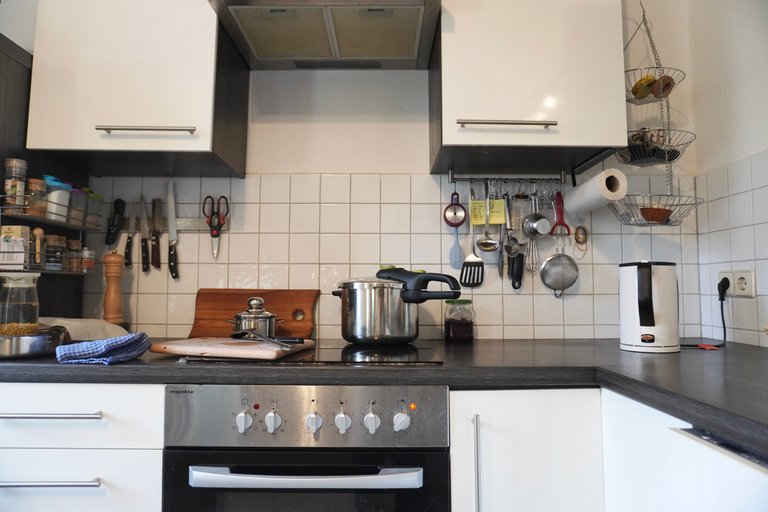
There is much more to write, but that's all for this time. I look forward to writing Soup Stories in the coming year 😊
Soup Stories
- Soup Stories #1: About this series and Spanish Bread Soup
- Soup Stories #2: Winter Schatz Soup
- Soup Stories #3: Chinese Egg Soup
- Soup Stories #4: Pumpkin Soup
- Soup Stories #5: Detox Leek Soup
- Soup Stories #6: Bean Friend's Chickpea Soup
- Soup Stories #7: Freestyle Miso Soup
- Soup Stories #8: Senegalese Mafé
- Soup Stories #9: Spring Color Turnip Soup
- Soup Stories #10: Ukrainian Borscht
- Soup Stories #11: Lentil Soup
- Soup Stories #12: Umami Cream Soup with Miso
- Soup Stories #13: Persian Eggplant and Tomato Stew
- Soup Stories #14: Gazpacho - Great Spanish Invention
- Soup Stories #15: Minestrone Soup
- Soup Stories #16: Goulash Soup
- Soup Stories #17: My mother's pot-au-feu
- Soup Stories #18: Chinese hot and sour soup
- Soup Stories #19: Alphabet Pasta Soup for Colds
- Soup Stories #20: Onion Gratin Soup
Soup Stories Side Stories
去年の冬Soup Storiesを書き始めて、他の人が作るのを意識しながらレシピを簡単にですが書き起こしてみると、改めていろいろなことが見えてきました。一年の終わりにおいしいスープ作るコツをまとめます。
1. 季節の新鮮な野菜があれば
ものすごくミニマルには、ポロネギをぶつ切りにして塩をぱらっとふっただけでデトックススープを作れます。

Soup Stories #5: Detox Leek Soup / ポロネギのデトックススープ
このほか、玉ねぎ、じゃがいも、にんじんを水から煮始めて、塩こしょうを加えて、ブレンダーで滑らかにするとすりながしのようなやさしいスープができます。まだSoup Storiesには書いていませんが、ポルトガルのカルドヴェルでというスープがこの系統の感じのスープです。

2. 基本の調味料は塩とこしょう
いい塩、大事です。ちょっと高いですが、山のように使うわけではないのでよしとしましょう。精製されすぎていない塩を用意するのがおすすめです。サラダや揚げ物にぱらっと振ってもおいしいです。
スープによっては胡椒が欠かせず、引き立てだとやっぱりいい香りがするので、簡易のミルに入ったこしょうを用意しておくとよいです。私はこしょうが大大大好きで大きい木製ミルを使っています。
加えて味噌や醤油があると便利です。ハーブは一気にいろいろ買い揃えるのは敷居が高いと思うので、まずはイタリアンハーブミックスといった手軽なものを買って、好みのものを買い足していくと挑戦しやすいです。
3. 油で炒めてコクを出す
水からじっくり煮てもおいしいですが、煮る前にバターや植物性の油で材料をささっと炒めてから煮ると、コクが出て、スープが一段と深い味になります。

味噌汁でも使える小技で、出汁がなくても十分美味しいくできます。豚汁を作る感じですね。
4. うまみ食材を使いこなす
グルタミン酸とイノシン酸、グルタミン酸とグアニル酸の組み合わせでうまみを出せます。イノシン酸は動物性の食品に含まれていることが多く、プラントベースにするのであればグルタミン酸とグアニル酸の組み合わせになります。グルタミン酸は野菜に含まれていて、グアニル酸は乾燥したキノコに含まれているので、組み合わせて旨味を出すのおすすめです。こうしてみると、昆布と干し椎茸の合わせだしになるほど納得です。このほか、クリームスープやシチューにほんの少しお味噌を足しても。
乾燥きのこ、ドライトマト、お味噌はうまみメーカーで、常備おすすめです 🍅 下の写真の右側のキノコはお友達が森でとってきて乾燥させたものです。

5. 豆や穀物、麺を足して満足感を出す
豆や穀物、麺を足すと、スープだけで満足できる一皿になります。スープに残ったご飯や豆を足したり、ショートパスタを一緒に煮て温めたり。スープ仕立てだと風邪ひきさんも食べやすいです。

Soup Stories #19: Alphabet Pasta Soup for Colds / 風邪ひきさんのアルファベットパスタスープ
卵を食べる人は、卵を足すのもおすすめです。最後に割り入れるだけ!

豆はまとめて煮ておいたり、瓶入りの物を買ったりして、すぐに使わない分は冷凍しておくと便利です。冷凍の豆はそのままスープに入れてしまってOKです。うちの冷凍庫には、ひよこ豆、あずき、白花豆・・・他にもまだ何か入っていそうです。
必須ではないけれど・・・圧力鍋があると便利!
圧力鍋はいつかギブアウェイをしたいくらい、便利で大好きです。グーラッシュやポトフなど、じっくりことこと系がのスープが30分で仕上がります。あと豆を煮るのにも便利です。私のは仕事で使うこともありやや大きいのですが、粛々といい仕事をしてくれます。

まだまだ書きたいことはあるのですが、今回はここまで。来年もSoup Storiesをどうぞよろしくお願いいたします😊
これまでのSoup Stories
- Soup Stories #1: このシリーズの紹介とスペインのパンスープ
- Soup Stories #2: 冬の宝物のスープ
- Soup Stories #3: 中華風卵スープ
- Soup Stories #4: かぼちゃのスープ
- Soup Stories #5: ポロネギのデトックススープ
- Soup Stories #6: ひよこ豆のスープ
- Soup Stories #7: 自由なお味噌汁
- Soup Stories #8: セネガルのマフェ
- Soup Stories #9: 春色のかぶのスープ
- Soup Stories #10: ウクライナのボルシチ
- Soup Stories #11: レンズ豆のスープ
- Soup Stories #12: 味噌の旨味のクリームスープ
- Soup Stories #13: ペルシャのナスとトマトのスープ
- Soup Stories #14: スペインの偉大な発明ガスパチョ
- Soup Stories #15: いつでもミネストローネスープ
- Soup Stories #16: グーラッシュスープ
- Soup Stories #17: 母のポトフ
- Soup Stories #18: 酸辣湯
- Soup Stories #19: 風邪ひきさんのアルファベットパスタスープ
- Soup Stories #20: オニオングラタンスープ
Thanks @robinia-green! You have a nice Rotkehlchen (robbin?) for your profile pic :)